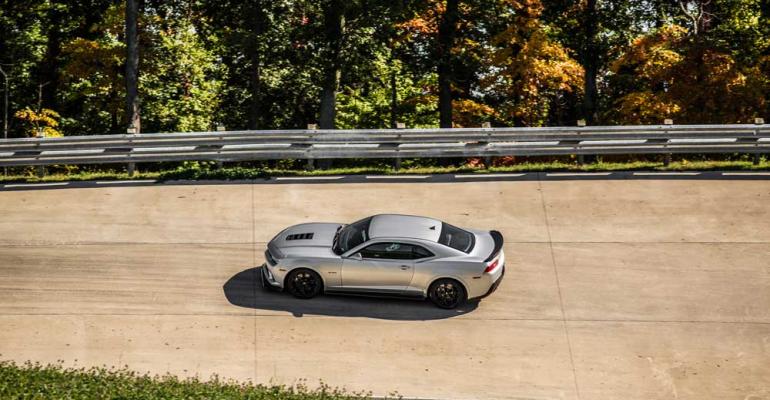MILFORD, MI– General Motors sees the Chevrolet Camaro extending its winning streak against the Ford Mustang this year and predicts a new Z/28 model will bolster its fortunes in 2014.
“We have everything, the styling and the performance,” says Al Oppenheiser, chief engineer for the Camaro lineup.
Camaro sales tumbled 4.4% last year to 84,391 units, squeezing past the Mustang’s 82,995 deliveries, up 17.8%, according to WardsAuto data. So far this year, Camaro sales are down 6.0% to 64,815, while Mustang deliveries are off 11.5% at 59,165.
Based on those results, Oppenheiser believes the fifth-generation Camaro, revived in 2009 as a ’10 model after a 7-year hiatus, may have altered forever one of the pony-car segment’s longstanding tenets by departing from a solid rear axle to an independent rear suspension.
Although the switch added 150 lbs. (68 kg) to the car, it transformed the Camaro from a light-to-light racer into a bona fide track machine and made it more palatable as a daily driver.
The sixth-generation Mustang, due next as ’15 model, is expected to adopt IRS. Ford officials are not commenting on the suspension layout of the new Mustang.
“I’ve been explaining for four years now about the (Camaro) being heavier,” Oppenheiser tells WardsAuto during a media preview of the Z/28.
“We win with styling, the larger wheels and tires and wide front track, and with performance from IRS. If I took those out, we would be pound-for-pound alongside the Mustang. But those are the things that help us win. This is an era when power isn’t everything.”
Oppenheiser expects the new Z/28 to take the Camaro’s track credentials to new levels. Mass reduction took center stage in its development, and GM spared no cost in pursuing the lightest, highest-performing parts, Oppenheiser says. Creature comforts such as air conditioning and a premium sound system were made optional.
The car will be sold exclusively in the U.S. and Canada, and if an item was not required by law there, it did not make onto the Z/28. The car does receive a functional rear seating area to retain its DNA as a 2 + 2 sports car, Oppenheiser says, but even then the seats are made of a lightweight construction.
“This is a track car,” he emphasizes, and given its driving dynamics few buyers other than the most enthusiastic will use it as a daily driver. “I love it. But it’s not for everyone. It follows the road, so you have to be ready to become one with the car.”
The Z/28 borrows a hand-built, naturally aspirated 505-hp 7.0L V-8 engine from the Corvette, but dials up the torque to an estimated 481 lb.-ft. (652 Nm). A close ratio 6-speeed manual transmission and a limited-slip differential with helical gears instead of traditional clutch packs put the power to the pavement.
Specially designed Brembo brakes combine with Pirelli Trofeo R tires to increase braking performance and grip.
Top-shelf suspension-damping technology from Multimatic appears on the Camaro, marking the first time it will be used outside of racing. The only other production car to receive the technology is the Aston Martin One-77.
GM credits the suite of exclusive technologies for helping the Z/28 deliver a Nurburgring time of 7:37.40, putting the car on par at the famous German test track with some of the world’s most prestigious sports cars. The Z/28 pulled its time in the rain, too, Oppenheiser notes. He says the car posted 7:31.9 in dry testing, although that is not considered an official time because cameras were not rolling.
“It’s a gentleman’s game over there,” he says.
Back in the U.S., the Z/28 covered the high-performance test track at GM’s proving grounds here in 01:53.71, nearly six seconds quicker than the Mustang Boss 302 Laguna Seca. It beat the Mustang GT500 by more than six seconds, GM says.
“That’s the shallow end of the pool now,” Oppenheiser says of the Mustang times. “We’re into the land of the Nissan GTR and Porsche GT3.”
The Z/28 will go on sale late in the first quarter. Pricing has not been determined, but it will cost more than the current top-of-the-range Camaro ZL1 that starts at about $55,000. The Z/28 will see two years of production at a volume of no more than 4,000 units. GM will back the car with a track-specific warranty.
Despite the popularity of the Z/28 name, which draws its nomenclature from the dealership order code for a high-performance Camaro package, bringing the variant to market was no slam dunk. Oppenheiser recalls that while the enthusiast community clamored for the car, GM management was initially skeptical about another Camaro: “‛We are trying to take the Chevrolet brand global and here we already have a stout Camaro lineup. Do you really need it?’”
Oppenheiser codenamed the Z/28 “Steve” during early development to keep its existence under wraps.
In fact, the ZL1 that went on sale last year originally was intended to be the Z/28, but its development took a different route. GM North American President Mark Reuss, design executive Tom Peters and GM Design Vice President Ed Welburn got behind the idea of a proper Z/28.
“We thought the Z/28 name would be let go for this generation, but Reuss said, ‘Hell, no. Let’s do something nobody can touch in the segment.’”





